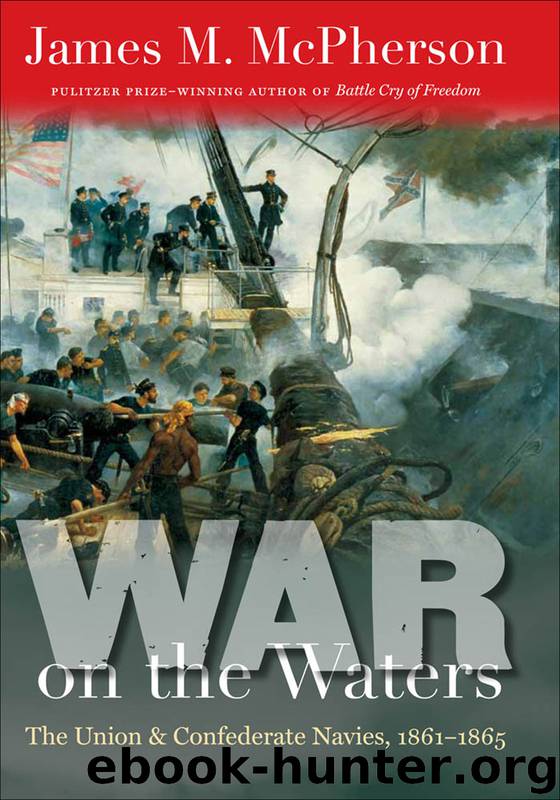War on the Waters by James M. McPherson

Author:James M. McPherson
Language: eng
Format: epub
Publisher: The University of North Carolina Press
Published: 2012-06-10T16:00:00+00:00
Charleston Harbor and Du Pont’s Attack on the Forts, April 7, 1863
can go pirouetting around the harbor and that the forts can be ‘run’—a la Mississippi—and that we can get to Charleston,” he wrote. But Du Pont intended to “run the Morris Island batteries” a mile or more outside the nexus of Sumter and Moultrie and the obstructions—which Fox had ignored—and then “take the bull (Sumter) by the horns. If we reduce him, which I believe we can, then we can take Morris Island in reverse, and if we can silence them we shall win a base and can get the troops ashore on the Island”—but still five miles from Charleston.23
AS THE PASSAIC-CLASS monitors began to arrive in January 1863, Du Pont decided to test them in attacks on Fort McAllister, a large earthwork mounting eight guns on the Ogeechee River south of Savannah. On January 27 he sent the USS Montauk under Captain John Worden (who had recovered from his wound as captain of the original Monitor in its fight with the Virginia) accompanied by three gunboats into the Ogeechee. While the wooden vessels stayed back at long range, the Montauk went up to the obstructions 1,600 yards from the fort and began a four-hour firefight in which neither ship nor fort did significant damage to the other. The Montauk was hit thirteen times without severe injury, which confirmed the ironclads’ “impenetrability,” Du Pont reported to Welles, but “there was no corresponding quality of aggression or destructiveness as against forts, the slowness of fire [seven or eight minutes between shots] giving full time for the gunners in the fort to take shelter in the bombproofs.” To a friend, Du Pont wrote: “I asked myself this morning, while quietly dressing, if an ironclad cannot take eight guns, how are five to take 147 guns in Charleston harbor?” “This experiment,” Du Pont informed Welles, only confirmed his conviction that “in all such operations to secure success troops are necessary.”24
Worden returned to the Ogeechee a month later after learning that the CSS Nashville, a former commerce raider and blockade-runner that had been bottled up in the river for eight months, had come down near Fort McAllister preparing to run out but had gone aground. Approaching within 1,200 yards and ignoring the shots rained on the Montauk from the fort, Worden shelled the Nashville, set her on fire, and blew her up when the fire reached the magazine.25
Elated by this demonstration of a single ironclad’s power against an enemy vessel if not against forts, Du Pont sent three other monitors (Passaic, Patapsco, and Nahant) to attack Fort McAllister again on March 3. This time, the ironclads plus their wooden consorts fought the fort for eight hours. They made the sand and turf fly and endured many hits in return, but they knocked out only one of McAllister’s guns. “It is wonderful the endurance of these vessels,” Du Pont conceded to Welles, but the damage they inflicted on the fort could be repaired in one night.
Download
This site does not store any files on its server. We only index and link to content provided by other sites. Please contact the content providers to delete copyright contents if any and email us, we'll remove relevant links or contents immediately.
| Africa | Americas |
| Arctic & Antarctica | Asia |
| Australia & Oceania | Europe |
| Middle East | Russia |
| United States | World |
| Ancient Civilizations | Military |
| Historical Study & Educational Resources |
1861 by Adam Goodheart(1023)
Smithsonian Civil War by Smithsonian Institution(971)
Abraham Lincoln: A Life, Volume 2 by Michael Burlingame(944)
The Fiery Trial by Eric Foner(915)
Ulysses S. Grant by Michael Korda(903)
Battle Cry of Freedom by James M. McPherson(898)
Rebel Yell: The Violence, Passion, and Redemption of Stonewall Jackson by S. C. Gwynne(895)
Rock of Chickamauga(884)
Abraham Lincoln in the Kitchen by Rae Katherine Eighmey(837)
This Republic of Suffering: Death and the American Civil War by Drew Gilpin Faust(824)
Bloody Engagements by John R. Kelso(798)
Lincoln's Lieutenants by Stephen W. Sears(778)
Union by Colin Woodard(771)
Leaves of Grass by Walt Whitman(768)
The escape and suicide of John Wilkes Booth : or, The first true account of Lincoln's assassination, containing a complete confession by Booth(751)
1861: The Civil War Awakening by Adam Goodheart(722)
Rise to Greatness by David Von Drehle(706)
The Fiery Trial: Abraham Lincoln and American Slavery by Eric Foner(705)
Leaves of Grass (Barnes & Noble Classics Series) by Walt Whitman(666)
